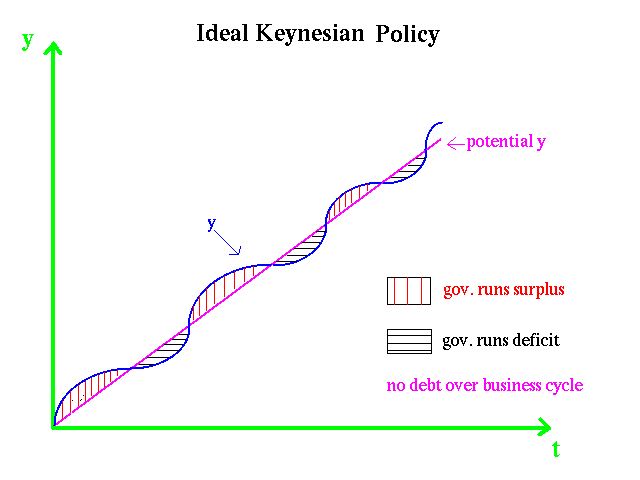
_____1. Supply Side economics
_____2. Social Choice Theory (Buchanan)
_____3. Neoclassical (Lucas and allies)

As pointed out by Buchanan, Keyes ignored the incentives which operate on the representatives as individuals. If we assume the representatives enjoy power, then we must consider what actions will they take during the Keynesian reaction to the business cycle. Representatives will take actions to please their constituents to maintain their votes. To get reelected a government surplus is an opportunity to fund more projects to gain voter approval.
If you will examine the deficit since the tax cut of 1964, which made Keynesian policy public policy, you will discover that the US federal government has run a surplus only three times.
Reelection incentives are too great to allow a representative government to run a surplus or take politically unpopular actions to balance the budget.
Expectations relate to the ability of individuals to use current information in order to forecast the future. Certainly as students you are aware that individuals can not precisely forecast the future. Take for example weather forecasts. The weather forecast gives the probability of rain the next day and subsequent days. The issue for economic modeling is whether individuals can accurately forecast averages. For example, if we flipped a fair coin, no one could accurately forecast the sequence of heads and tails. But individuals could forecast that if we flipped the coin, say, the percent of head would be approximately 50%.
The rational expectations hypothesis assumes that people know the true model of the economy and that they accurately forecast expected values of economic variables. With rational expectations markets on average would be in equilibrium and that disequilibrium such as unemployment occurs as a result of random, unpredictable shocks.
The Lucas supply function assumes that output depends on the difference between the actual price level and the expected price level:
__________
The Lucas supply function is based in information differentials. Managers know more about prices in their industry and other industries and workers know more about their wages than wages in other industries. A price surprise is the difference between the actual price and the expected price. If there is a positive price surprise then output goes up because managers will expand output and workers will be willing to work longer hours.
If we consider the policy implications of the Lucas supply model, government can increase output only be fooling managers and workers into perceiving a positive price surprise. If we assume that economic agents have rational expectations then any announced policy will have no affect of real output because the announced policy will affect the price level and expected price level in the same way.
Macroeconomists are divided into neoclassical adherents and more eclectic thinkers who consider the neoclassical assumptions far too strong. The point is that most macroeconomists believe that government can do much less to effectively stablize the economy than was believed in the 1960s.
Much of the focus in macroeconomics has shifted from stabilization policy to growth policy. Can we stimulate the economy to grow an extra 1% a year. This would increase real incomes and might reduce racial tension.